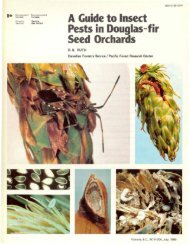decay of aspen and balsam poplar in alberta - Canadian Forest ...
decay of aspen and balsam poplar in alberta - Canadian Forest ...
decay of aspen and balsam poplar in alberta - Canadian Forest ...
You also want an ePaper? Increase the reach of your titles
YUMPU automatically turns print PDFs into web optimized ePapers that Google loves.
DECAY OF ASPEN AND BALSAM POPLAR IN ALBERTA<br />
Y. Hiratsuka <strong>and</strong> A. A. Lomanl<br />
INFORMATION REPORT NOR-X-262<br />
NORTHERN FOREST RESEARCH CENTRE<br />
CANADIAN FORESTRY SERVICE<br />
ENVIRONMENT CANADA<br />
1984<br />
I Loman <strong>and</strong> Associates, 4915 Vanguard Road N.W., Calgary Alberta T3A ORS
j<br />
©M<strong>in</strong>ister <strong>of</strong> Supply <strong>and</strong> Services Canada 1984<br />
Catalogue No. F046·12/262E<br />
ISBN 0·662·13377-3<br />
ISSN 0704· 7673<br />
This publication is available at no charge from:<br />
Northern <strong>Forest</strong> Research Centre<br />
<strong>Canadian</strong> <strong>Forest</strong>ry Service<br />
Environment Canada<br />
5320 - 122 Street<br />
Edmonton, Alberta<br />
T6H 3S5<br />
II
Hiratsuka, Y.; Loman, A.A. 1984. Decay <strong>of</strong> <strong>aspen</strong> <strong>and</strong> <strong>balsam</strong> <strong>poplar</strong> <strong>in</strong> Alberta. Environ. Can., Can. For. Serv.,<br />
North. For. Res. Cent., Edmonton, Alberta. Inf. Rep. NOR·X·262.<br />
ABSTRACT<br />
Aspen (Po/>ulus tremuloides Michx.) <strong>and</strong> <strong>balsam</strong><br />
<strong>poplar</strong> (P. <strong>balsam</strong>ifera L. ) represent about 40% <strong>of</strong><br />
Alberta's forest resources, but utilization is only 1% <strong>of</strong><br />
the total available. Decay <strong>and</strong> sla<strong>in</strong> are two major factors<br />
limit<strong>in</strong>g utilization <strong>of</strong> these species. Major <strong>decay</strong>-caus<strong>in</strong>g<br />
agents <strong>and</strong> types <strong>of</strong> <strong>decay</strong> <strong>of</strong> <strong>aspen</strong> <strong>and</strong> <strong>balsam</strong> <strong>poplar</strong><br />
are reviewed, <strong>and</strong> the implications for management <strong>and</strong><br />
utilization are discussed.<br />
III<br />
RESUME<br />
Le peuplier faux-tremble (Populus tremuloides<br />
Michx.) et Ie peuplier baumier (P. <strong>balsam</strong>ifera L.)<br />
constituent environ 40% des ressources forestieres de<br />
l'Alberta, rnais leur utilisation ne s'eleve qu'a 1 % du total<br />
disponible. Les deux pr<strong>in</strong>cipaux facteurs limitant leur<br />
utilisation sont la carie et les taches colones. Les<br />
pr<strong>in</strong>cipaux agents et les types de caries observes chez ces<br />
deux essences sont discutes, de meme que leurs<br />
repercussions sur I'amenagement et I'utilisation de ces<br />
essences.
CONTENTS<br />
INTRODUCTION ............................. ............. ........................... 1<br />
MAJOR DECA Y·CAUSING AGENTS AND TYPES OF DECA Y .. ........................... 1<br />
AGE·DECA Y RELATIONSHIPS. . . . . .... .. . . .... . .... . . . . .. ... .... . .... .. .. . . .. . . . . . .. .. 9<br />
SITE· DECAY RELATIONSHiPS ...... .. ...... ........ ............... ................... 9<br />
CLONE·DECA Y RELATIONSHIPS . . . . . . . . . . . . . . . . .. . . . . . . . . . . . . . . . . . . . . . . . . . . . . . . . . . . . . 10<br />
CULL EST IMATION WITH EXTERNAL INDICATORS .. ........ ............. ...... ....... 12<br />
ASPEN AND BALSAM POPLAR DECAY MANAGEMENT.. .................. ............. 14<br />
SIGNIFICANCE OF DECAY AND DISCOLORATION TO ASPEN AND BALSAM POPLAR<br />
UTIL IZATION ................... .................... .................... ......... 16<br />
Plywood......................... ................ . ............................. 16<br />
Dimension lumber t boards, <strong>and</strong> timbers ..................................... ........ .<br />
Wafer board. flakeboar, chipboard, <strong>and</strong> oriented str<strong>and</strong> board. . . . . . . . . . . . . . . . . . . . . . . . . . . 16<br />
Pulp <strong>and</strong> paper .. ..................... ............... .................... ...... . 16<br />
Integrated wood products complex. . . . . . . . . . . . . . . . . . . . . . . . . . . . . . . . . . . . . . . . . . . . . . . . . . 16<br />
Conversion <strong>of</strong> biomass <strong>in</strong>to energy <strong>and</strong> chemicals . . . . . . . . . . . . . . . . . . . . . . . . . . . . . . . . . . . . . . 1 7<br />
Cattle feed. . . . . . . . . . . . . . . . . . . . . . . . . . . . . . . . . . . . . . . . . . . . . . . . . . . . . . . . . . . . . . . . . . . . . 17<br />
Cultivation <strong>of</strong> edible mushrooms. . . . . . . . . . . . . . . . . . . . . . . . . . . . . . . . . . . . . . . . . . . . . . . . . . . . 17<br />
CONCLUSIONS. . . . . . . . . . . . . . . . . . . . . . . . . . . . . . . . . . . . . . . . . . . . . . . . . . . . . . . . . . . . . . . . . . . . . . . 17<br />
RECOMMENDATIONS . . . . . . . . . . . . . . . . . . . . . . . . . . . . . . . . . . . . . . . . . . . . . . . . . . . . . . . . . . . . . . . . 17<br />
REFERENCES 18<br />
FIGURES<br />
1.. Poplar distribution across Canada <strong>and</strong> estimated gross merchantable volume for each prov<strong>in</strong>ce or<br />
region.. . . ... . . . . . . . . . . .. . . . . .. . . ... . . . . .. . . . . . . . . . . . . .. . . . .. . . . . . . . ... . . . . . . . .. . . 2<br />
2. Potential annual forest yield <strong>of</strong> coniferous <strong>and</strong> deciduous (mostly <strong>poplar</strong>) species <strong>in</strong> Alberta. . . . . . . . 3<br />
3. Pure <strong>aspen</strong> st<strong>and</strong> along a logg<strong>in</strong>g road near Blue Ridge, Alberta . . . . . . . . . . . . . . . . . . . . . . . . . . . . . 4<br />
4. A st<strong>and</strong> <strong>of</strong> mature <strong>aspen</strong> near Blue Ridge, Alberta, after s<strong>of</strong>twood harvest . . . . . . . . . . . . . . . . . . . . . 4<br />
5. Vertical section <strong>of</strong> an <strong>aspen</strong> stem with fruit<strong>in</strong>g body <strong>of</strong> Phell<strong>in</strong>us tremulae <strong>and</strong> a column <strong>of</strong> advanced<br />
<strong>decay</strong> bordered by characteristic black l<strong>in</strong>es. . . . . . . . . . . . . . . . . . . . . . . . . . . . . . . . . . . . . . . . . . . . . . 5<br />
6. Cross section <strong>of</strong> an <strong>aspen</strong> stem with advanced <strong>decay</strong> caused by Phell<strong>in</strong>us tremulae . . . . . . . . . . . . . . 5<br />
7. Relation <strong>of</strong> rotten knot <strong>and</strong> <strong>decay</strong> column <strong>of</strong> Phell<strong>in</strong>us tremulae <strong>in</strong> <strong>aspen</strong> . ....... .............. 5<br />
8. A fruit<strong>in</strong>g body (conk) <strong>of</strong> Phell<strong>in</strong>us tremulae on <strong>aspen</strong> . ... . . . . . . . . .. . .. . . . . . . . . . .. . . . . ... . . 5<br />
9. Fruit<strong>in</strong>g structure <strong>of</strong> Peniophora polygonia on <strong>aspen</strong>. . . . . . . . . . . . . . . . . . . . . . . . . . . . . . . . . . . . . . . 7<br />
10. Large scars (cracks) on mature <strong>balsam</strong> <strong>poplar</strong>. . . ... . . .. . . . ... . .. .. . . . .. . ... .. .. . . . . . . .. . . 7<br />
11. Dead branch <strong>and</strong> column <strong>of</strong> discolored <strong>in</strong>cipient <strong>decay</strong> <strong>of</strong> <strong>aspen</strong> caused by Peniophora polygonia . . . 7<br />
12. Fruit<strong>in</strong>g bodies (mushrooms) <strong>of</strong> Pholiota destruens on <strong>balsam</strong> <strong>poplar</strong>. . . . . . . . . . . . . . . . . . . . . . . . . . 7<br />
13. Brown butt rot <strong>of</strong> <strong>balsam</strong> <strong>poplar</strong>. probably caused by Armillaria mellea . . . . . . . . . . . . . . . . . . . . . . . 8<br />
14. Butt rot (brown rot) <strong>of</strong> <strong>aspen</strong> caused by Armillaria mellea . . . . . . . . . . . . . . . . . . . . . . . .. . . . . . . . . . 8<br />
IV<br />
Page
15. Black gall on <strong>aspen</strong> . . . . . . . . . . . . . . . . . . . . . . . . . . . . . . . . . . . . . . . . . . . . . . . . . . . . . . . . . . . . . . . . . 8<br />
16. Representation <strong>of</strong> average tree dimensions <strong>and</strong> size, position, <strong>and</strong> shape <strong>of</strong> <strong>decay</strong> columns <strong>in</strong> some <strong>aspen</strong><br />
clones <strong>in</strong> two Manitoba locations (Manigotogan <strong>and</strong> Robl<strong>in</strong>). . . . . . . . . . . . . . . . . . . . . . . . . . . . . . . . . 11<br />
17. Decay <strong>of</strong> <strong>balsam</strong> <strong>poplar</strong> show<strong>in</strong>g a scar <strong>and</strong> a branch knot as the entry po<strong>in</strong>ts for an unknown <strong>decay</strong><br />
organism . . . . . . . . . . . . . . . . . . . . . . . . . . . . . . . . . . . . . . . . . . . . . . . . . . . . . . . . . . . . . . . . . . . . . . . . : . 13<br />
18. Extensve stem damage at the bottom <strong>of</strong> a mature <strong>balsam</strong> <strong>poplar</strong> . . . . . . . .. . . . . . . . . ... . . : ... , . . 13<br />
19. An old healed wound on a small diameter <strong>aspen</strong> with fruit<strong>in</strong>g bodies <strong>of</strong> Peniophora polygonia. . . . .. 13<br />
20. A long scar on a mature <strong>aspen</strong> with conks <strong>of</strong> Phell<strong>in</strong>us tremulae . . . . . . . . . . . . . . . . . . . . . . . . . . . . . 13<br />
TABLES<br />
1. Percentage <strong>in</strong>fections by major <strong>decay</strong>-caus<strong>in</strong>g fungi on <strong>aspen</strong> <strong>and</strong> <strong>balsam</strong> <strong>poplar</strong> <strong>in</strong> the Slave Lake area<br />
<strong>of</strong> Alberta. . . .. . . . . . . .. . . . .. .. . . .. .. . . . .. .. . .. . . . .. . . .. . . .. . . .. . . . . . .. . . .. . . . . . 9<br />
2. Age-<strong>decay</strong> relationships <strong>in</strong> <strong>aspen</strong> st<strong>and</strong>s <strong>in</strong> Canada <strong>and</strong> the United States . . _ _ . . _ . . _ . . . . . . . . . . . . 10<br />
3. Age-<strong>decay</strong> relationships <strong>in</strong> <strong>balsam</strong> <strong>poplar</strong> st<strong>and</strong>s <strong>in</strong> Alberta . . . . . . . . . . . . . . . . . . . . . . . . . . . . . . . _ . 12<br />
4. Relationship between visible Phell<strong>in</strong>us tremulae fruit<strong>in</strong>g bodies <strong>and</strong> the occurrence <strong>of</strong> <strong>decay</strong> <strong>in</strong><br />
<strong>aspen</strong> _ . . . .. . . .. . . . . . . . . . . . .. . . . . . . . . .. . . . . . . . . . .. . . . . . . . . .. . . _ . . . . . . . . . . . . . . . . . . . 15<br />
5. Relationship between <strong>decay</strong> <strong>and</strong> sta<strong>in</strong> occurrence <strong>and</strong> external <strong>in</strong>dicators <strong>in</strong> <strong>aspen</strong> sampled at Blue<br />
Ridge, Alberta, <strong>in</strong> 1982.... ... .. .... .... ... .... .... .. ...... .. ... .... .... .... ... .. . ... 15<br />
v
Hardwoods, mostly <strong>aspen</strong> (Populus tremuloides<br />
Michx.) <strong>and</strong> <strong>balsam</strong> <strong>poplar</strong> (P. <strong>balsam</strong>ifera L. ), repre·<br />
sent about 40% <strong>of</strong> Alberta's forest resources. Current<br />
utilization amounts to only about 1 % <strong>of</strong> the total, but the<br />
time is fast approach<strong>in</strong>g when the s<strong>of</strong>twood resources will<br />
be harvested to their limits <strong>of</strong> annual allowable cut. The<br />
<strong>aspen</strong>·<strong>balsam</strong> <strong>poplar</strong> resource will then be expected to<br />
play a much more significant role <strong>in</strong> meet<strong>in</strong>g the dem<strong>and</strong><br />
for forest products <strong>in</strong> the future. The relative amounts <strong>of</strong><br />
hardwood (mostly <strong>poplar</strong>) volume across Canada <strong>and</strong><br />
potential annual allowable cut <strong>in</strong> Alberta are shown <strong>in</strong><br />
Figures 1 <strong>and</strong> 2. Typical <strong>aspen</strong> forests <strong>in</strong> Alberta are<br />
illustrated <strong>in</strong> Figures 3 <strong>and</strong> 4. Three other <strong>poplar</strong> species<br />
(black cottonwood, P. trichocarpa Torr. & Gray; eastern<br />
cottonwood, P. deltoides Bartr.; <strong>and</strong> narrowleaf cotton<br />
wood, P. angustifolia James) also occur <strong>in</strong> Alberta, but<br />
they are economically <strong>in</strong>significant.<br />
Decay <strong>and</strong> sta<strong>in</strong> have been identified as two <strong>of</strong> the<br />
most important factors limit<strong>in</strong>g the utilization <strong>of</strong> <strong>aspen</strong><br />
<strong>and</strong> <strong>balsam</strong> <strong>poplar</strong>. Several terms used <strong>in</strong> this report are<br />
def<strong>in</strong>ed as follows: Incipient <strong>decay</strong> <strong>in</strong>dicates an early<br />
stage <strong>of</strong> <strong>decay</strong> <strong>in</strong> which the wood is hard <strong>and</strong> firm but<br />
may show discoloration or dark l<strong>in</strong>es. Advanced <strong>decay</strong><br />
refers to an advanced stage <strong>of</strong> <strong>decay</strong> <strong>of</strong> wood that is<br />
s<strong>of</strong>tened <strong>and</strong> has lost structural strength. Sta<strong>in</strong> is a<br />
discoloration <strong>of</strong> wood by microoganisms or other physio<br />
logical causes <strong>and</strong> may or may not be the early stage <strong>of</strong><br />
<strong>in</strong>cipient <strong>decay</strong>.<br />
INTRODUCTION<br />
Many reports conta<strong>in</strong><strong>in</strong>g <strong>in</strong>formation on <strong>decay</strong> <strong>of</strong><br />
<strong>aspen</strong> <strong>and</strong> <strong>balsam</strong> <strong>poplar</strong> ha ve been published <strong>in</strong> various<br />
parts <strong>of</strong> North America, <strong>in</strong>clud<strong>in</strong>g Alberta. The most<br />
significant <strong>and</strong> relevant contributions are the follow<strong>in</strong>g:<br />
Alberta (Bailey <strong>and</strong> Dobie 1977; Paul <strong>and</strong> Etheridge<br />
1958; Thomas et al. 1960), Manitoba <strong>and</strong> Saskat·<br />
chewan (Wall 1971; Black <strong>and</strong> Kristapovich 1954),<br />
Ontario (Basham 1958, 1979; Riley 1952), Colorado<br />
(Davidson et al. 1959; H<strong>in</strong>ds <strong>and</strong> Wengert 1977), <strong>and</strong><br />
M<strong>in</strong>nesota (Me<strong>in</strong>ecke 1929). Unfortunately, the above·<br />
mentioned reports <strong>and</strong> many others written on the subject<br />
are not easily accessible because they have been<br />
reported mostly <strong>in</strong> specialized scientific journals or<br />
unpublished government reports.<br />
The purpose <strong>of</strong> this report is to compile <strong>and</strong> review<br />
available <strong>in</strong>formation on <strong>decay</strong> <strong>of</strong> <strong>aspen</strong> <strong>and</strong> <strong>balsam</strong><br />
<strong>poplar</strong> <strong>and</strong> to attempt to <strong>in</strong>terpret it <strong>in</strong> relation to <strong>aspen</strong><br />
<strong>poplar</strong> management <strong>and</strong> utilization <strong>in</strong> Alberta.<br />
This report was prepared orig<strong>in</strong>ally for the Alberta<br />
Poplar Research Committee, composed jo<strong>in</strong>tly <strong>of</strong><br />
personnel from the Alberta <strong>Forest</strong> Service (J. Soos,<br />
B. Karaim, <strong>and</strong> E. Gillespie) <strong>and</strong> Blue Ridge Lumber<br />
(1981) Ltd. (M. Summers, P. Caldwell, <strong>and</strong> R. Kerr)<br />
<strong>and</strong> chaired by A.D. Kiil <strong>of</strong> the <strong>Canadian</strong> <strong>Forest</strong>ry<br />
Service.<br />
MAJOR DECAY-CAUSING AGENTS AND TYPES OF DECAY<br />
Many fungi have been isolated <strong>and</strong> identified from<br />
<strong>decay</strong> <strong>and</strong> sta<strong>in</strong> <strong>of</strong> <strong>aspen</strong> <strong>and</strong> <strong>balsam</strong> <strong>poplar</strong> (Basham<br />
1958; Gilbertson 1981; H<strong>in</strong>ds <strong>and</strong> Wengert 1977;<br />
L<strong>in</strong>dsey <strong>and</strong> Gilbertson 1978; Thomas et aI. 1960; Wall<br />
1971). Fourteen major <strong>decay</strong> fungi have been isolated<br />
<strong>and</strong> identified from <strong>in</strong>cipient <strong>and</strong> advanced <strong>decay</strong> <strong>in</strong><br />
<strong>aspen</strong> <strong>and</strong> <strong>balsam</strong> <strong>poplar</strong> <strong>in</strong> the Slave Lake area <strong>of</strong><br />
Alberta by Thomas et al. (1960) (Table I). Accord<strong>in</strong>g<br />
to Thomas et al., Phell<strong>in</strong>us tremulae (Fomes igniarius)<br />
is the most common <strong>and</strong> important <strong>decay</strong>-caus<strong>in</strong>g<br />
organism <strong>in</strong> both <strong>aspen</strong> <strong>and</strong> <strong>balsam</strong> <strong>poplar</strong>. This species<br />
has also been identified as the ma<strong>in</strong> <strong>decay</strong> organism <strong>of</strong><br />
<strong>aspen</strong> <strong>in</strong> other parts <strong>of</strong> North America (Basham 1958;<br />
Black <strong>and</strong> Kristapovich 1954; H<strong>in</strong>ds <strong>and</strong> Wengert 1977;<br />
Me<strong>in</strong>ecke 1929; Wall 1971). This fungus is commonly<br />
called the false t<strong>in</strong>der fungus <strong>and</strong> causes s<strong>of</strong>t yellowish<br />
<strong>and</strong> characteristic brown to blackish brown l<strong>in</strong>es surround<br />
<strong>in</strong>g each <strong>decay</strong> column (Figs. 5· 7). Ho<strong>of</strong>·shaped sporo·<br />
phores (conks) <strong>of</strong> P. tremulae are about 10 em <strong>in</strong> width<br />
(Fig. 8). The upper side <strong>of</strong> the sporophore is greyish<br />
black at first <strong>and</strong> later becomes cracked <strong>and</strong> appears<br />
c<strong>in</strong>der·like. The undersurface is covered with brown to<br />
whitish-brown spore-produc<strong>in</strong>g tubes. The <strong>in</strong>terior <strong>of</strong><br />
a conk is dark brown (Fig. 5).<br />
On <strong>aspen</strong>, Radulum casearium <strong>and</strong> Peniophora<br />
polygonia (Corticium polygonium) have been commonly<strong>and</strong><br />
constantly isolated from yellowish or reddish<br />
str<strong>in</strong>gy rot <strong>and</strong> from variously colored (brown, yellow,<br />
red) <strong>in</strong>cipient <strong>decay</strong>s. They are considered to be the next<br />
most important <strong>aspen</strong> <strong>decay</strong> after P. tremulae (Basham<br />
1958; Black <strong>and</strong> Kristapovitch 1954; Laflamme <strong>and</strong><br />
Lortie 1973; Thomas et al. 1960; Wall 197 1).<br />
Characteristically, P. polygonia has been isolated<br />
from younger <strong>aspen</strong> trees, <strong>and</strong> most isolations were from<br />
<strong>in</strong>cipient <strong>decay</strong> (Basham 1958). Sporophores <strong>of</strong><br />
P. polygonia are <strong>of</strong>ten observed on branch stubs <strong>of</strong> trees<br />
1
2<br />
Figure 1.<br />
337<br />
255<br />
D 0 0 0<br />
B.C. Alta. Sask. Man. Onto Que. Maritimes<br />
175 171<br />
Poplar volume (millions <strong>of</strong> m3)<br />
42<br />
c:::J<br />
,- . ,-<br />
Poplar distribution across Canada (shaded area) <strong>and</strong> estimated gross merchantable volume for<br />
each prov<strong>in</strong>ce or region (based on Bonnor 1982).
4b?na<br />
CANADA<br />
PEA CE RIVER FORE ST<br />
C 1138<br />
D 1 950<br />
FOOTNER LAKE FOREST<br />
C 1 564<br />
02150<br />
r--- WHITECOURT FOREST<br />
EDSON FOREST<br />
POTENTIAL ANNUAL<br />
FOREST YIELD<br />
1980<br />
C 1280 CONIfeROUS VOLUME IN THOUSANDS<br />
OF CUBIC METRES PER YEAR<br />
0510<br />
DECIDUOUS VOLUME IN THOUSANDS<br />
OF CUBIC METRES PER YEAR '<br />
C 1446<br />
01250<br />
SLAVE LAKE<br />
FOREST<br />
C 1765<br />
02 970<br />
WOOD<br />
W A TERTON LAKES<br />
.... .<br />
NATIONAL PARK<br />
BUFFALO<br />
NATIONAL<br />
PAAK<br />
ATHABASCA<br />
FOREST<br />
C 1 432<br />
o 880<br />
LAC LA BICHE<br />
FOREST<br />
C 761<br />
D 1190<br />
Figure 2. Potential annual forest yield <strong>of</strong> coniferous <strong>and</strong> deciduous (mostly <strong>poplar</strong>) species <strong>in</strong> Alberta.<br />
(Alberta <strong>Forest</strong> Service map.)<br />
3
4<br />
Figure 3. Pure <strong>aspen</strong> st<strong>and</strong> along a logg<strong>in</strong>g road near Blue Ridge, Alberta. Figure 4. A st<strong>and</strong> <strong>of</strong> mature <strong>aspen</strong><br />
near Blue Ridge, Alberta, after s<strong>of</strong>twood harvest.
Figure 5. Vertical section <strong>of</strong> an <strong>aspen</strong> stem with a fruit<strong>in</strong>g body <strong>of</strong> Phell<strong>in</strong>us lremulae <strong>and</strong> a column <strong>of</strong> advanced<br />
<strong>decay</strong> bordered by characteristic black l<strong>in</strong>es. Figure 6. Cross section <strong>of</strong> an <strong>aspen</strong> stem with advanced <strong>decay</strong><br />
caused by Phell<strong>in</strong>us tremulae. Figure 7. Relation <strong>of</strong> rotten knot <strong>and</strong> <strong>decay</strong> column <strong>of</strong> Phell<strong>in</strong>us tremulae <strong>in</strong><br />
<strong>aspen</strong>. Figure 8. A fruit<strong>in</strong>g body (conk) <strong>of</strong> Phell<strong>in</strong>us tremulae on <strong>aspen</strong>.<br />
5
:1<br />
;'<br />
i<br />
:!<br />
6<br />
Table 1. Percentage <strong>in</strong>fections by major <strong>decay</strong>caus<strong>in</strong>g fungi on <strong>aspen</strong><br />
<strong>and</strong> <strong>balsam</strong> <strong>poplar</strong> <strong>in</strong> the Slave Lake area <strong>of</strong> Alberta. Based on<br />
Thomas et al. (1960).<br />
Trunk<br />
Phell<strong>in</strong>us tremulae 13.4<br />
(=Fomes igniarius)<br />
Radulum casearium 14.2<br />
Peniophora polygonia 12.8<br />
(=Corticium polygonium)<br />
Coriolus zonulus 2. 1<br />
(=Polyporus zonulus)<br />
Bjerk<strong>and</strong>ra adusto 1.5<br />
(=Polyporus adustus)<br />
Pholiota adiposa 0.5<br />
Phlebia strigosa-zonata<br />
Armillaria mellea<br />
(=Armillariella mellea)<br />
Gymnopilus spectabilis 0.1<br />
(=Pholiota spectabilis)<br />
Pholiota destruens<br />
COfticium expallens<br />
Trechispora raduloides 0.5<br />
COfficium vellerum<br />
Pholiota subsquarrosa<br />
Mixed 12.4<br />
Unknown 10.7<br />
Total 89.2<br />
<strong>of</strong> small dimensions (Fig. 9) or on old stem scars<br />
(Fig. 10). The wood support<strong>in</strong>g sporophore.bear<strong>in</strong>g<br />
branch stubs or stem scars is characteristically <strong>in</strong> a state<br />
<strong>of</strong> yellowish <strong>and</strong> p<strong>in</strong>kish <strong>in</strong>cipient <strong>decay</strong> (Fig. 11).<br />
Peniophora polygonia is seldom associated with ad<br />
vanced <strong>decay</strong>.<br />
Although R. casearium is commonly isolated from<br />
liv<strong>in</strong>g trees, sporophores are usua!ly found only on dead<br />
trees. They are resup<strong>in</strong>ate, yellow-brown, <strong>and</strong> have<br />
coarse teeth. Basham (1958) suggested that<br />
R. casearium may be the cause <strong>of</strong> most <strong>of</strong> the character<br />
istic advanced str<strong>in</strong>gy trunk rot <strong>of</strong> - <strong>aspen</strong>_<br />
Aspen Balsam <strong>poplar</strong><br />
Butt Trunk Butt<br />
0.2 26.8<br />
1.2<br />
1. 5<br />
trace<br />
0. 7 2.5 0.1<br />
0. 2<br />
2. 2<br />
0. 9 trace 1.6<br />
1.2 1.3 4. 2<br />
17.7 0.4<br />
5. 2 0.4<br />
trace 0.8 0.1<br />
0.4<br />
0.7<br />
0. 3 0.1<br />
1. 4 34.7 3.5<br />
10.8 89.5 10.5<br />
Of the three most dom<strong>in</strong>ant <strong>decay</strong> fungi on liv<strong>in</strong>g<br />
trees mentioned above, only R. casearium is commonly<br />
isolated from stored log piles, <strong>in</strong>dicat<strong>in</strong>g that the vitality<br />
<strong>of</strong> the other two species decreases <strong>in</strong> storage (Fritz<br />
1954).<br />
On <strong>balsam</strong> <strong>poplar</strong>, P. tremulae is aga<strong>in</strong> recognized<br />
as the most common <strong>and</strong> dom<strong>in</strong>ant <strong>decay</strong>-caus<strong>in</strong>g<br />
species, followed by Pholiota destruens (Fig. 12),<br />
Corticium expallens, <strong>and</strong> Bjerk<strong>and</strong>ra adusta<br />
(=Polyporus adustus) from trunk rot <strong>and</strong> Gymnopilus<br />
spectabilis (=Pholiota spectabilis) <strong>and</strong> Armillaria<br />
mellea from butt <strong>in</strong>fections (Figs. 13, 14) (Thomas et
Figure 9. Fruit<strong>in</strong>g structure <strong>of</strong> PeniophC;ra poiygonia on <strong>aspen</strong>. Figure 10. Large scars (cracks) on mature<br />
<strong>balsam</strong> <strong>poplar</strong>. Figure 11. Dead branch <strong>and</strong> column <strong>of</strong> discolored <strong>in</strong>cipient <strong>decay</strong> <strong>of</strong> <strong>aspen</strong> caused by<br />
Peniophora po/ygonia. Inside <strong>of</strong> Figure 9. Figure 12. Fruit<strong>in</strong>g bodies (mushrooms) <strong>of</strong> Pholiota destruens on<br />
<strong>balsam</strong> <strong>poplar</strong>.<br />
7
, '<br />
!<br />
8<br />
Fig';"e 13. Brown butt rot <strong>of</strong> <strong>balsam</strong> <strong>poplar</strong>, probably caused by Armillaria mellea. Figure 14. Butt rot<br />
(brown rot) <strong>of</strong> <strong>aspen</strong> caused by Armillaria mellea. Figure 15. Black gall on <strong>aspen</strong>.
al. 1960). Decay caused by unkn'Own organisms<br />
accounted for 38.2% (34.7% <strong>of</strong> trunk <strong>in</strong>fections <strong>and</strong><br />
3.5% <strong>of</strong> butt <strong>in</strong>fections), which is greater than <strong>decay</strong><br />
volume due to P. tremulae (26.8%) (Thomas et al.<br />
1960). More <strong>in</strong>vestigations are needed to determ<strong>in</strong>e the<br />
unknown organisms caus<strong>in</strong>g the <strong>decay</strong> <strong>in</strong> this species <strong>and</strong><br />
the relative importance <strong>of</strong> <strong>decay</strong> fungi.<br />
Many bacteria <strong>and</strong> other fungi are constantly<br />
isolated from <strong>decay</strong>ed <strong>and</strong> sta<strong>in</strong>ed tissues (Etheridge<br />
1961; Good <strong>and</strong> Nelson 1962; Laflamme <strong>and</strong> Lortie<br />
Aspen <strong>and</strong> <strong>balsam</strong> <strong>poplar</strong> are shade· <strong>in</strong>tolerant<br />
species. hence they tend to grow <strong>in</strong> even-aged st<strong>and</strong>s.<br />
These st<strong>and</strong>s orig<strong>in</strong>ate primarily by means <strong>of</strong> sucker<strong>in</strong>g<br />
after forest fires or logg<strong>in</strong>g. Regeneration <strong>of</strong> shade<br />
<strong>in</strong>t'Olerant <strong>aspen</strong> <strong>and</strong> <strong>balsam</strong> <strong>poplar</strong> ceases when the<br />
forest canopy is closed.<br />
Age-<strong>decay</strong> relationships are usually tabulated <strong>in</strong><br />
10-20 year classes; theref'Ore, all published age-<strong>decay</strong><br />
relationships show <strong>decay</strong> percentages <strong>of</strong> <strong>aspen</strong> <strong>and</strong><br />
<strong>balsam</strong> <strong>poplar</strong>-that are ranked by the ages <strong>of</strong> unrelated,<br />
noncomparable <strong>aspen</strong> <strong>and</strong> <strong>balsam</strong> <strong>poplar</strong> st<strong>and</strong>s.<br />
Because each st<strong>and</strong> is unique with respect to fire history,<br />
genetic orig<strong>in</strong>, site quality, <strong>and</strong> species composition,<br />
there is a great variability <strong>in</strong> the data ·published by<br />
different researchers. Tables 2 <strong>and</strong> 3 demonstrate how<br />
<strong>aspen</strong> <strong>decay</strong> <strong>and</strong> <strong>balsam</strong> <strong>poplar</strong> <strong>decay</strong> percentages vary<br />
across Canada <strong>and</strong> the United States. A second major<br />
cause <strong>of</strong> the high variability <strong>of</strong> data published on age·<br />
<strong>decay</strong> relationships <strong>in</strong> <strong>aspen</strong> <strong>and</strong> <strong>balsam</strong> P'Oplar relates to<br />
the lack <strong>of</strong> clear dist<strong>in</strong>ction between <strong>in</strong>cipient <strong>and</strong><br />
advanced <strong>decay</strong> <strong>and</strong> between sta<strong>in</strong> <strong>and</strong> <strong>in</strong>cipient <strong>decay</strong>.<br />
A third cause <strong>of</strong> variability is the selection <strong>of</strong> different<br />
assessment st<strong>and</strong>ards <strong>in</strong> the various <strong>decay</strong> <strong>and</strong> cull<br />
surveys.<br />
Pedology Consultants (1982) analyzed 10 15 trees<br />
<strong>in</strong> the O'Chiese Block <strong>of</strong> the Rocky.Clearwater <strong>Forest</strong>.<br />
Fire history <strong>in</strong> this forest district has restric·ted the growth<br />
Frequently, a wide range 'Of diameters exists <strong>in</strong><br />
even-aged <strong>aspen</strong> st<strong>and</strong>s because <strong>of</strong> variati'Ons <strong>in</strong> site<br />
quality <strong>and</strong> competition by surr'Ound<strong>in</strong>g trees. This<br />
makes it difficult to obta<strong>in</strong> correlations between tree age<br />
1973; Shigo 1967; Thomas et aI. 1960). These are not<br />
c'Onsidered <strong>decay</strong>·caus<strong>in</strong>g organisms, but they are<br />
believed t'O play an important role-<strong>in</strong> microbial succession<br />
lead<strong>in</strong>g to <strong>in</strong>cipient <strong>decay</strong> <strong>in</strong> <strong>aspen</strong> <strong>and</strong> <strong>poplar</strong>_<br />
On trembl<strong>in</strong>g <strong>aspen</strong>, blackish galls with a rough<br />
surface are <strong>of</strong>ten found (Fig. 15), but the <strong>in</strong>terior <strong>of</strong> the<br />
galls is sound <strong>and</strong> not ass'Ociated with <strong>decay</strong>. Except for<br />
one tree with large scars <strong>and</strong> conks, about 20 trees with<br />
black galls did not have conks <strong>and</strong> did not have<br />
advanced <strong>decay</strong>l.<br />
AGE-DECAY RELATIONSHIPS<br />
SITE-DECAY RELATIONSHIPS<br />
t Field observations at Blue Ridge, Alberta, <strong>in</strong> 1982 by Y. Hiratsuka <strong>and</strong> A.A. Loman.<br />
<strong>of</strong> <strong>aspen</strong> <strong>and</strong> <strong>balsam</strong> <strong>poplar</strong> st<strong>and</strong>s to s<strong>in</strong>gle age classes.<br />
Eighty-five percent <strong>of</strong> their 1015 sample trees were over<br />
45 years old, <strong>and</strong> the average age was 70 years. Their<br />
estimated <strong>decay</strong> percentage was 8.7% f'Or <strong>aspen</strong> <strong>and</strong><br />
7.40/0 for <strong>balsam</strong> <strong>poplar</strong> <strong>and</strong> did not <strong>in</strong>clude unmerchant<br />
able stems. Only merchantable sawlogs with less than<br />
50% <strong>decay</strong> <strong>and</strong> hav<strong>in</strong>g more than 9.0 cm top diameter<br />
were analyzed. Bailey <strong>and</strong> Dobie (1977) employed<br />
similar st<strong>and</strong>ards <strong>of</strong> utilization, <strong>and</strong> obta<strong>in</strong>ed comparable<br />
results (Tables 1 <strong>and</strong> 2). Paul <strong>and</strong> Etheridge (1958)<br />
analyzed <strong>decay</strong> <strong>and</strong> cull relationships at the logg<strong>in</strong>g site.<br />
For <strong>aspen</strong> they show nearly five times more <strong>decay</strong> (30%)<br />
<strong>in</strong> the 51·60 year age class than Bailey <strong>and</strong> Dobie<br />
(6.2%), five times more <strong>decay</strong> <strong>in</strong> the 71·80 years age<br />
class, <strong>and</strong> three times more <strong>decay</strong> <strong>in</strong> the 91-100 years<br />
age class. For <strong>balsam</strong> <strong>poplar</strong>, Bailey <strong>and</strong> Dobie show<br />
nearly equal <strong>decay</strong> percentages throughout 140 years <strong>of</strong><br />
age (range 0.7%), while Paul <strong>and</strong> Etheridge show a<br />
range <strong>of</strong> 21.6% through 170 years <strong>of</strong> age.<br />
In general, <strong>decay</strong> percentages <strong>of</strong> gross volume<br />
<strong>in</strong>crease with age; however, c'Omparisons between pub<br />
lished results obta<strong>in</strong>ed by different researchers across<br />
Canada <strong>and</strong> the United States are difficult. Although<br />
preselection <strong>and</strong> rejecti'On <strong>of</strong> unmerchantable logs at the<br />
logg<strong>in</strong>g site give low <strong>decay</strong> <strong>in</strong>cidence figures <strong>in</strong> s'Ome<br />
surveys (Bailey <strong>and</strong> Dobie 1977; Pedology Consultants<br />
1982), the high labor costs <strong>of</strong> fell<strong>in</strong>g, cutt<strong>in</strong>g, <strong>and</strong><br />
select<strong>in</strong>g may make the operation uneconomical.<br />
<strong>and</strong> diameter. When diameter limit cuts provided the<br />
stems for <strong>decay</strong> <strong>and</strong> volume analyses (Bailey <strong>and</strong> Dobie<br />
1977; Pedology Consultants 1982), poor correlations<br />
were found between age <strong>and</strong> <strong>decay</strong> (Tables 2 <strong>and</strong> 3).<br />
9
10<br />
Table 2. Age.<strong>decay</strong> relationships <strong>in</strong> <strong>aspen</strong> st<strong>and</strong>s <strong>in</strong> Canada <strong>and</strong> the United States<br />
Age class Manitoba-<br />
(years) M<strong>in</strong>nesota a<br />
E. S",k b<br />
31-40 1.4<br />
41·50 1.8<br />
51·60 4.7 3.2<br />
61·70 5.9 7.1<br />
71·80 5.6 14.4<br />
81·90 3.0 21.3<br />
91·100 11.5 25.2<br />
101·110 18.1 31.1<br />
111·120 26.5 36.9<br />
121·130 41.5 41.9<br />
131·140 10.3<br />
141·150 22.5<br />
151·160<br />
161·170<br />
171·180<br />
a Me<strong>in</strong>ecke (1929).<br />
b Black <strong>and</strong> Kristapovich (1954).<br />
c<br />
Riley (1952).<br />
d<br />
Basham (1958).<br />
e<br />
Paul <strong>and</strong> Etheridge (1958).<br />
f Bailey <strong>and</strong> Dobie (1977).<br />
g H<strong>in</strong>ds <strong>and</strong> Wengert (1977).<br />
h Pedology Consultants (1982).<br />
Petawawa, Upper Pic.<br />
OntarioC Ontario d<br />
2.9<br />
4.4<br />
5.9 1.0<br />
7.4<br />
8.9 3.0<br />
Better correlations between site <strong>and</strong> <strong>decay</strong> were<br />
obta<strong>in</strong>ed when the factors <strong>of</strong> site quality <strong>and</strong> competition<br />
were considered. Paul <strong>and</strong> Etheridge (1958) divided the<br />
sample trees <strong>in</strong>to fast- <strong>and</strong> slow-grow<strong>in</strong>g classes. Slow<br />
grow<strong>in</strong>g <strong>aspen</strong> <strong>and</strong> <strong>poplar</strong> occur as a rule on the poor<br />
sites <strong>and</strong> very rarely make up the understory trees on the<br />
better sites. The fast-grow<strong>in</strong>g trees usually occur on good<br />
sites but may occasionally <strong>in</strong>clude some dom<strong>in</strong>ants from<br />
In -<strong>aspen</strong>, highly significant differences have been<br />
found between clones <strong>in</strong> percentage <strong>decay</strong>, volume <strong>of</strong><br />
<strong>decay</strong>, gross volume, <strong>and</strong> net volume (Kemperman et al.<br />
1978; Wall 1969, 1971). Wall (1971) reported that<br />
5.0<br />
8.0<br />
8.0<br />
15.0<br />
17.0<br />
Percentage <strong>decay</strong><br />
Lesser Slave Lesser Slave Rocky-Clear-<br />
Lake, Alta. e<br />
Lake, Alta. i<br />
Colorado g<br />
water, Alta. h<br />
12.0<br />
14.0<br />
30.0 6.2 6.5<br />
40.0<br />
42.0 8.4 14.5 8.7<br />
40.0<br />
36.0 12.2 23.0<br />
33.0<br />
30.0 31.0<br />
45.0<br />
48.5<br />
the poorer sites. The diameter classes y'ield<strong>in</strong>g the<br />
maximum net <strong>in</strong>crements <strong>in</strong> fast- <strong>and</strong> slow-grow<strong>in</strong>g<br />
<strong>aspen</strong> were 35 em <strong>and</strong> 30 em, respectively. In fast- <strong>and</strong><br />
slow·grow<strong>in</strong>g <strong>balsam</strong> <strong>poplar</strong>, the diameter classes<br />
yield<strong>in</strong>g the maximum net <strong>in</strong>crement were 58 em <strong>and</strong><br />
56 em, respectively. It appears, however, that genetic<br />
factors significantly affect site-<strong>decay</strong> relationships <strong>in</strong><br />
<strong>aspen</strong>.<br />
CLONE·DECA Y RELATIONSHIPS<br />
each clone had a unique pattern with respect to position<br />
<strong>of</strong> rot columns with<strong>in</strong> the stem (Fig. 16) <strong>and</strong> the major<br />
types <strong>of</strong> rot present. Adjacent or <strong>in</strong>term<strong>in</strong>gled clones<br />
apparently on the same site differed significantly
.... ..<br />
E<br />
--<br />
-<br />
.&:.<br />
01<br />
"OJ<br />
J: 20<br />
10<br />
Manigotogan<br />
Robl<strong>in</strong> 20 em<br />
Radius<br />
Figure t 6. Representation <strong>of</strong> average tree dimensions <strong>and</strong> size, position, <strong>and</strong> shape <strong>of</strong> <strong>decay</strong> columns <strong>in</strong> some<br />
<strong>aspen</strong> clones <strong>in</strong> two Manitoba locations (Manigotogan <strong>and</strong> Robl<strong>in</strong>), Solid outer l<strong>in</strong>es represent<br />
bark layer. Inner solid l<strong>in</strong>es <strong>in</strong>dicate <strong>decay</strong> columns (from Wall 1971).<br />
11
12<br />
Table 3. Age-<strong>decay</strong> relationships <strong>in</strong> <strong>balsam</strong> <strong>poplar</strong> st<strong>and</strong>s <strong>in</strong><br />
Alberta<br />
Percentage <strong>decay</strong><br />
Age class Lesser Slave Lake Rocky-Clearwater<br />
(years) 1958a 1977b,c forestsd 31-40 2. 9<br />
41·50 8.7<br />
51·60 8. 2<br />
61·70 7.4<br />
71·80 8. 4<br />
81·90 10.1<br />
91·100 11.4<br />
101·110 13.3<br />
111·120 15.2<br />
121·130 l7.3<br />
131·140 19.4<br />
141·150 21.3<br />
151·160 22.9<br />
161·170 24.5<br />
171·180<br />
a Paul <strong>and</strong> Etheridge (1958),<br />
b Bailey <strong>and</strong> Dobie (1977).<br />
C Preselected logs.<br />
d Pedology Consultants (1982).<br />
<strong>in</strong> percentage <strong>decay</strong> <strong>in</strong> several <strong>in</strong>stances. Components <strong>of</strong><br />
the same clone occupy<strong>in</strong>g two dist<strong>in</strong>guishable sites did<br />
not differ significantly <strong>in</strong> percent <strong>decay</strong> <strong>in</strong> any <strong>of</strong> the<br />
clones harvested, but considerable differences <strong>in</strong> gross<br />
volumes <strong>and</strong> <strong>decay</strong> volumes were observed between<br />
clones. In one study (Wall 1969), the <strong>in</strong>cidence <strong>of</strong> P.<br />
tremulae among <strong>in</strong>term<strong>in</strong>gled clones on the same site<br />
varied from 12% to 64%; on another site the variation<br />
ranged from 21 % to 92%.<br />
6. 2<br />
5.0<br />
5.5<br />
7.4<br />
The above observations <strong>in</strong>dicate that the genetic<br />
orig<strong>in</strong> <strong>of</strong> <strong>aspen</strong> is more important than site quality. When<br />
<strong>aspen</strong> <strong>and</strong> <strong>poplar</strong> utilization become economically attrac<br />
tive, the identification <strong>of</strong> genetically healthy <strong>aspen</strong> clones<br />
will be important <strong>in</strong> regeneration programs (Steneker<br />
1976; Steneker <strong>and</strong> Wall 1970).<br />
<strong>poplar</strong>.<br />
No published work is available on clones <strong>of</strong> <strong>balsam</strong><br />
CULL ESTIMATION WITH EXTERNAL INDICATORS<br />
Attempts have been made to f<strong>in</strong>d a method to<br />
predict- relative <strong>in</strong>cidence <strong>and</strong> extent <strong>of</strong> <strong>decay</strong> before<br />
harvest<strong>in</strong>g is planned. Most <strong>of</strong> the published work uses<br />
external <strong>in</strong>dicators such as sporophores (ma<strong>in</strong>ly conks <strong>of</strong><br />
P. tremuiae, Fig. 8), rotten knots, <strong>and</strong> ma<strong>in</strong> stem scars<br />
(Figs. 10, 17·20) (Bailey 1974; Bailey <strong>and</strong> Dobie 1977;<br />
Basham 1958; Riley <strong>and</strong> Biers 1936) to predict <strong>decay</strong> <strong>in</strong><br />
the tree stems. Balsam <strong>poplar</strong> does not produce fruit<strong>in</strong>g<br />
bodies <strong>of</strong> P. tremulae easily, <strong>and</strong> external <strong>in</strong>dicators <strong>of</strong><br />
<strong>decay</strong> are ma<strong>in</strong>ly ,rotten knots <strong>and</strong> large scars (Fig. 10).
Figure 17. Decay <strong>of</strong> <strong>balsam</strong> <strong>poplar</strong> show<strong>in</strong>g a scar <strong>and</strong> a branch knot as the entry po<strong>in</strong>ts for an unknown <strong>decay</strong><br />
organism. Figure 18. Extensive stem damage at the bottom <strong>of</strong> a mature <strong>balsam</strong> <strong>poplar</strong>. Figure 19. An old<br />
healed wound on a small diameter <strong>aspen</strong> with fruit<strong>in</strong>g bodies <strong>of</strong> Peniophora polygonia. Figure 20. A long<br />
scar on a mature <strong>aspen</strong> with conks <strong>of</strong> Phell<strong>in</strong>us tremulae.<br />
13
14<br />
Among the <strong>in</strong>dicators mentioned above, the<br />
presence <strong>of</strong> conks <strong>of</strong> P. tremulae was found to <strong>in</strong>dicate a<br />
significant amount <strong>of</strong> advanced <strong>decay</strong>. Basham (1958)<br />
found that between 61.1 % <strong>and</strong> 97.6% (average 86.2%)<br />
<strong>of</strong> trees with one or mOre P. tremulae conks had<br />
advanced <strong>decay</strong> (Table 4). At Blue Ridge, Alberta, 17<br />
out <strong>of</strong> 18 sampled trees (94.5%) with conks <strong>and</strong>/or large<br />
scars had a significant amount <strong>of</strong> advanced <strong>decay</strong>, but<br />
only 1 <strong>of</strong> 6 trees (16.7%) without external <strong>in</strong>dicators had<br />
advanced <strong>decay</strong> (Table 5). Although the number <strong>and</strong><br />
distribution patterns <strong>of</strong> conks <strong>and</strong> other external <strong>in</strong>dica<br />
tors may <strong>in</strong>dicate the shape <strong>and</strong> extent <strong>of</strong> <strong>decay</strong> columns,<br />
no quantitative prediction <strong>of</strong> relative amount <strong>of</strong> ad-<br />
vanced <strong>decay</strong> can be made from exam<strong>in</strong><strong>in</strong>g external<br />
<strong>in</strong>dicators.<br />
Consider<strong>in</strong>g the strong clonal uniformity <strong>of</strong> <strong>decay</strong><br />
patterns discussed previously, a mean<strong>in</strong>gful <strong>decay</strong> pre<br />
diction scheme may be established by check<strong>in</strong>g several<br />
selected trees for major clones <strong>in</strong> the area concerned.<br />
Anderson <strong>and</strong> Schipper (1978) proposed a system<br />
for predict<strong>in</strong>g the amount <strong>of</strong> P. tremulae rot <strong>in</strong> <strong>aspen</strong> by<br />
apply<strong>in</strong>g a constant (1.9) to the st<strong>and</strong> basal area with<br />
P. tremulae conks <strong>in</strong> M<strong>in</strong>nesota.<br />
ASPEN AND BALSAM POPLAR DECAY MANAGEMENT<br />
Aspen <strong>and</strong> <strong>balsam</strong> <strong>poplar</strong> <strong>decay</strong> management,<br />
sound silviculture practice (Steneker 1976), utilization,<br />
<strong>and</strong> market<strong>in</strong>g are <strong>in</strong>terdependent <strong>in</strong> a free market<br />
economy <strong>and</strong> cannot be discussed separately <strong>in</strong> a<br />
mean<strong>in</strong>gful way. Ultimately, the <strong>aspen</strong> <strong>and</strong> <strong>balsam</strong><br />
<strong>poplar</strong> <strong>decay</strong> management <strong>in</strong> Alberta is dependent on<br />
match<strong>in</strong>g the biological characteristics <strong>of</strong> these species<br />
with 1) available utilization technology, 2) the dem<strong>and</strong><br />
for specific products on a longwterm basis, <strong>and</strong> 3) the<br />
distance to markets. As long as any one <strong>of</strong> these three<br />
factors is unfavorable, <strong>aspen</strong> <strong>and</strong> <strong>poplar</strong> <strong>decay</strong> managew<br />
ment will cont<strong>in</strong>ue to be irrelevant <strong>in</strong> Alberta.<br />
Several biological characteristics <strong>of</strong> <strong>aspen</strong> <strong>and</strong><br />
<strong>balsam</strong> <strong>poplar</strong> regenerate almost exclusively from root<br />
suckers, which share a vast network <strong>of</strong> roots. Early<br />
growth after forest fires or clear.cutt<strong>in</strong>g is extremely<br />
rapid, giv<strong>in</strong>g <strong>aspen</strong> <strong>and</strong> <strong>balsam</strong> <strong>poplar</strong> (but also alder<br />
<strong>and</strong> willow species) an advantage over trees that<br />
regenerate from seeds <strong>and</strong> over compet<strong>in</strong>g grasses,<br />
shrubs, <strong>and</strong> herbs.<br />
The most healthy <strong>and</strong> vigorous root suckers grow<br />
after all mature <strong>aspen</strong> <strong>and</strong> <strong>balsam</strong> <strong>poplar</strong> have been<br />
removed (Walters et al. 1982). Even a few residual<br />
mature trees left st<strong>and</strong><strong>in</strong>g after harvest<strong>in</strong>g will be<br />
dom<strong>in</strong>ant competitors <strong>of</strong> root suckers for available<br />
nutrients through their common root system. Walters et<br />
al. also found that partial cutt<strong>in</strong>g <strong>of</strong> 60·80% <strong>of</strong> basal area<br />
may ma<strong>in</strong>ta<strong>in</strong> an <strong>aspen</strong> caver type, but rema<strong>in</strong><strong>in</strong>g large<br />
trees degenerate rapidly with <strong>decay</strong> <strong>and</strong> other pathow<br />
logical conditions (Walters et al. 1982).<br />
All species that regenerate vegetatively grow<br />
rapidly; but they also have very short pathological<br />
rotation ages. Harvest<strong>in</strong>g at pathological rotation age<br />
means harvest<strong>in</strong>g when <strong>decay</strong> rates beg<strong>in</strong> to exceed<br />
growth rates, which is estimated as 40w50 years for<br />
<strong>aspen</strong> <strong>and</strong> 70·80 years for <strong>balsam</strong> <strong>poplar</strong> by Paul <strong>and</strong><br />
Etheridge (1958), although most other <strong>decay</strong> studies<br />
<strong>in</strong>dicate a higher pathological rotation age. In Alberta,<br />
harvest<strong>in</strong>g at low pathological rotation age means<br />
harvest<strong>in</strong>g <strong>aspen</strong> <strong>and</strong> <strong>balsam</strong> <strong>poplar</strong> <strong>of</strong> small diameters<br />
unless th<strong>in</strong>n<strong>in</strong>g programs are adopted (Steneker <strong>and</strong><br />
Jarvis 1966).<br />
Economics dictate a m<strong>in</strong>imum return per hectare <strong>in</strong><br />
terms <strong>of</strong> merchantable fiber volume. B iological conw<br />
stra<strong>in</strong>ts <strong>and</strong> the dem<strong>and</strong> for forest products derived from<br />
small diameter trees determ<strong>in</strong>e whether the costs <strong>in</strong>w<br />
volved <strong>in</strong> <strong>decay</strong> management <strong>and</strong> <strong>aspen</strong>w<strong>poplar</strong> silvicuI<br />
ture are justified. To date this has not been the case <strong>in</strong><br />
Alberta.<br />
If the successes from ongo<strong>in</strong>g research <strong>in</strong> cellulose<br />
<strong>and</strong> hemicellulose recovery (Boone <strong>and</strong> Cyr 1981; Cyr<br />
<strong>and</strong> Schultz 1982) from sta<strong>in</strong>ed <strong>and</strong> <strong>decay</strong>ed <strong>aspen</strong> <strong>and</strong><br />
<strong>balsam</strong> <strong>poplar</strong> can be synchronized with a dem<strong>and</strong> for<br />
cellulose <strong>and</strong> hemicellulose <strong>and</strong> their derivatives, the<br />
<strong>decay</strong> management <strong>of</strong> Alberta's <strong>aspen</strong> <strong>and</strong> <strong>poplar</strong> forests<br />
will also change. For example, if up to 70% <strong>of</strong> the<br />
<strong>decay</strong>ed wood conta<strong>in</strong>s extractabl , utilizable cellulose<br />
<strong>and</strong> hemicellulose, the pathological rotation age for<br />
<strong>aspen</strong> at 40wSO years becomes irrelevant, <strong>and</strong> a different<br />
economic rotation age would be selected. If the presence<br />
<strong>of</strong> advanced <strong>decay</strong> is not the limit<strong>in</strong>g factor for utilization,<br />
the cont<strong>in</strong>ued <strong>in</strong>crease <strong>in</strong> volume per unit area would be<br />
achieved at up to 100·110 years for <strong>aspen</strong> <strong>and</strong> 140·150<br />
years for <strong>balsam</strong> <strong>poplar</strong> (Paul <strong>and</strong> Etheridge 1958).
Table 4. Relationship between visible Phell<strong>in</strong>us tremulae fruit<strong>in</strong>g bodies <strong>and</strong><br />
the occurrence <strong>of</strong> <strong>decay</strong> <strong>in</strong> <strong>aspen</strong> (Basham 1958)<br />
No. trees wIth one<br />
Age class No. trees No. trees or more visible % <strong>of</strong> trees with<br />
(years) sampled with <strong>decay</strong> fruit<strong>in</strong>g bodies fruit<strong>in</strong>g bodies<br />
41-60 131 18 11 61.1<br />
61·80 271 52 41 78.8<br />
81·100 553 183 150 82.0<br />
101·120 357 179 151 84.4<br />
121-140 165 100 86 86.0<br />
141-160 238 170 166 97.6<br />
161-180 39 29 25 86.2<br />
Table 5. Relationship between <strong>decay</strong> <strong>and</strong> sta<strong>in</strong> occurrence <strong>and</strong><br />
external <strong>in</strong>dicators <strong>in</strong> <strong>aspen</strong> a sampled at Blue Ridge,<br />
Alberta, <strong>in</strong> 1982<br />
External<br />
<strong>in</strong>dicators<br />
Conks<br />
Conks <strong>and</strong><br />
scars<br />
Scars<br />
Rotten knots<br />
No external<br />
<strong>in</strong>dicators<br />
Total<br />
Percentage<br />
a Age range 75-80 years.<br />
No. trees<br />
4<br />
1<br />
11<br />
2<br />
6<br />
24<br />
Sta<strong>in</strong> <strong>and</strong><br />
advanced<br />
<strong>decay</strong><br />
4<br />
10<br />
2<br />
18<br />
75<br />
Sta<strong>in</strong><br />
1<br />
4<br />
5<br />
21<br />
No <strong>decay</strong><br />
4<br />
15
16<br />
SIGNIFICANCE OF DECAY AND D1SCOLORA nON TO<br />
ASPEN AND BALSAM POPLAR unUZA nON<br />
Plywood<br />
Plywood production dem<strong>and</strong>s <strong>decay</strong>.free, high.<br />
quality logs for veneer. Discoloration also downgrades<br />
the products. Besides discoloration <strong>and</strong> <strong>decay</strong>, the<br />
follow<strong>in</strong>g problems contributed to the failure <strong>of</strong> the <strong>poplar</strong><br />
plywood <strong>in</strong>dustry <strong>in</strong> Alberta (Rytz 1980a; Wells 1980).<br />
a) The·high <strong>in</strong>cidence <strong>of</strong> <strong>decay</strong> resulted <strong>in</strong> enormous<br />
amounts <strong>of</strong> waste at the logg<strong>in</strong>g <strong>and</strong> mill sites.<br />
b) Decay-free trees <strong>of</strong> peeler quality were scattered<br />
over vast areas <strong>in</strong> the forest, mak<strong>in</strong>g harvest<strong>in</strong>g<br />
costly.<br />
c) Not all <strong>decay</strong> was detected <strong>in</strong> the forest, hence at the<br />
mill site the volume <strong>of</strong> waste material due to <strong>decay</strong><br />
was enormous.<br />
d) Poplar is difficult to peel because <strong>of</strong> r<strong>in</strong>g shake, rot<br />
pockets, <strong>and</strong> tension wood.<br />
e) Defects <strong>in</strong> veneer result <strong>in</strong> a sheet ratio that is<br />
generally below 50%. Defects are oversized knots,<br />
splits, feathered gra<strong>in</strong>, <strong>and</strong> r<strong>in</strong>g shake.<br />
f) The high moisture content <strong>in</strong> <strong>poplar</strong> <strong>in</strong>creases the<br />
shipp<strong>in</strong>g costs.<br />
g) Higher moisture content <strong>in</strong> <strong>poplar</strong> veneer requires<br />
15% more dry<strong>in</strong>g time than spruce to reduce the<br />
moisture content to 5%.<br />
h) Dryer loss is substantial because <strong>of</strong> cracks <strong>and</strong> splits<br />
that open up <strong>in</strong> the dry<strong>in</strong>g process.<br />
i) Poplar veneer requires 8·10% more glue than is<br />
required for spruce.<br />
Dimension lumber, boards, <strong>and</strong> timbers<br />
With respect to a previous sawmill operation <strong>in</strong> the<br />
Slave Lake area, lumber recovery from logs to merchant·<br />
able material was only 15% <strong>of</strong> the total volume h<strong>and</strong>led<br />
because <strong>of</strong> the presence <strong>of</strong> advanced <strong>and</strong> <strong>in</strong>cipient <strong>decay</strong>.<br />
Enormous waste burners, more than double the capacity<br />
required for s<strong>of</strong>twoods, were needed. Also, compared<br />
with s<strong>of</strong>twoods, hardwood lumber requires 2.5 to 4. 0<br />
times as long to kiln dry (Rytz 1980a). As a result, there<br />
are the additional capital <strong>and</strong> carry<strong>in</strong>g costs for extra kiln<br />
capacity. Twenty percent <strong>of</strong> <strong>poplar</strong> studs from Alberta<br />
were classified as economy grade, the lowest <strong>of</strong> four<br />
grades. This was a much greater percentage than that for<br />
s<strong>of</strong>twoods.<br />
Wafer board, f1akeboard, chipboard,<br />
<strong>and</strong> oriented str<strong>and</strong> board<br />
Clear <strong>decay</strong>.free logs are -not as essential for the<br />
production <strong>of</strong> wafer board, flakeboard, <strong>and</strong> oriented<br />
str<strong>and</strong> board as they are for plywood. Decayed wood<br />
def<strong>in</strong>itely affects these products, however, <strong>and</strong> could be a<br />
critical factor <strong>in</strong> the success <strong>of</strong> a mill produc<strong>in</strong>g them.<br />
Pulp <strong>and</strong> paper<br />
Excessive amounts <strong>of</strong> <strong>decay</strong>ed wood processed by<br />
a pulp mill are known to affect the yield <strong>and</strong> quality <strong>of</strong><br />
pulp <strong>and</strong> the quality <strong>of</strong> paper products (Fritz 1954;<br />
Hatton 1974; Hunt et al. 1978) MacLeod et al. (1982)<br />
reported success <strong>in</strong> design<strong>in</strong>g a chip improvement<br />
process (Paprifer Chip Improvement Process) that elimi<br />
nates most <strong>of</strong> the <strong>decay</strong>ed wood <strong>and</strong> produces chips <strong>of</strong><br />
the same quality as chips from sound healthy wood. If<br />
this type <strong>of</strong> process is <strong>in</strong>corporated <strong>in</strong>to a pulp<strong>in</strong>g<br />
operation, the <strong>in</strong>cidence <strong>and</strong> amount <strong>of</strong> <strong>decay</strong> would<br />
have no <strong>in</strong>fluence on utilization as long as sufficient<br />
sound wood was available.<br />
Integrated wood products complex<br />
The best way to utilize the <strong>poplar</strong> resource appears<br />
to be through the development <strong>of</strong> an <strong>in</strong>tegrated complex<br />
to m<strong>in</strong>imize waste caused by <strong>decay</strong>, poor quality logs,<br />
<strong>and</strong> rejected f<strong>in</strong>ished products. The objective would be to<br />
develop as many high.value.added products as possible<br />
to <strong>of</strong>fset the high logg<strong>in</strong>g <strong>and</strong> manufactur<strong>in</strong>g costs. In the<br />
process <strong>of</strong> obta<strong>in</strong><strong>in</strong>g sound wood <strong>in</strong> the logg<strong>in</strong>g as well as<br />
the mill<strong>in</strong>g phase there is much waste, <strong>and</strong> other users<br />
must be found for the residual fiber that is generated.<br />
Such a complex could consist <strong>of</strong> a plywood plant, a wafer<br />
board mill, a sawmill, <strong>and</strong> a mill us<strong>in</strong>g waste (i.e.,<br />
particleboard mill, chemical conversion plant). The<br />
waste can be used as an energy source for the mill. For<br />
this type <strong>of</strong> complex, the wood would be allocated as<br />
follows:<br />
a) The highest·quality logs would be sent to the<br />
plywood mill for veneer.<br />
b) Thirty to fifty percent <strong>of</strong> the better-quality wood<br />
would h sent to the sawmill.<br />
c) All rejected wood from the first two processes would<br />
then be sent to reconstituted board production,<br />
supplemented by roundwood as required.<br />
d) These three processes would generate by·products<br />
such as shav<strong>in</strong>gs, chips, rejects, low-quality round<br />
wood, bark, sawdust, f<strong>in</strong>es, <strong>and</strong> oversized pieces, all<br />
<strong>of</strong> which could be processed by a plant us<strong>in</strong>g all<br />
fibers regardless <strong>of</strong> quality.
Conversion <strong>of</strong> biomass <strong>in</strong>to energy <strong>and</strong> chemicals<br />
The advantage <strong>of</strong> consider<strong>in</strong>g Alberta's <strong>aspen</strong><strong>balsam</strong><br />
<strong>poplar</strong> <strong>in</strong>ventory as a source <strong>of</strong> biomass is that all<br />
available wood biomass would be utilized regardless <strong>of</strong><br />
the presence <strong>and</strong> extent <strong>of</strong> <strong>decay</strong> <strong>in</strong> the wood. All<br />
cellulose materials-bole, bark, branches <strong>and</strong> twigs,<br />
foliage, <strong>and</strong> roots-can be converted to energy<br />
(Silversides 1980). Biomass harvest<strong>in</strong>g for energy<br />
means be<strong>in</strong>g able to low-grade the forest, leav<strong>in</strong>g the best<br />
trees for conventional forest products. The best har<br />
vest<strong>in</strong>g system is complete clear-cutt<strong>in</strong>g to improve<br />
stock<strong>in</strong>g, rapid growth, <strong>and</strong> natural th<strong>in</strong>n<strong>in</strong>g. Arguments<br />
aga<strong>in</strong>st use <strong>of</strong> biomass for energy purposes were outl<strong>in</strong>ed<br />
by Kennedy (1980), who claimed that l<strong>and</strong> assembly,<br />
soil depletion through short rotations, <strong>and</strong> common<br />
sense economics make hardwood energy plann<strong>in</strong>g unat<br />
tractive.<br />
With the abundance <strong>of</strong> natural gas, oil, <strong>and</strong> espe<br />
cially coal <strong>in</strong> Alberta <strong>and</strong> British Columbia, ethanol can<br />
be manufactured more efficiently <strong>and</strong> cheaply from<br />
natural gas than from wood. It is therefore uneconomical<br />
to make wood sugar from hardwoods <strong>and</strong> then ferment it<br />
to ethanol.<br />
Cattle feed<br />
Steamed <strong>poplar</strong> chips have good digestibility <strong>and</strong><br />
provide an energy component to cattle feed. The <strong>aspen</strong>-<br />
1. A significant amount <strong>of</strong> early advanced <strong>decay</strong> is<br />
<strong>in</strong>herent <strong>in</strong> <strong>aspen</strong> <strong>and</strong> <strong>balsam</strong> <strong>poplar</strong> <strong>in</strong> Alberta <strong>and</strong><br />
is caused ma<strong>in</strong>ly by Phell<strong>in</strong>us tremulae.<br />
2. Very little <strong>in</strong>formation is available on <strong>decay</strong> <strong>of</strong><br />
<strong>balsam</strong> <strong>poplar</strong> compared to that <strong>of</strong> <strong>aspen</strong>.<br />
3. Various <strong>decay</strong> loss studies <strong>in</strong>dicate that the amount<br />
<strong>of</strong> <strong>decay</strong> <strong>in</strong>creases with age, although reported<br />
figures are varied.<br />
' 4. Each clone seems to have its own <strong>decay</strong> pattern,<br />
which is less <strong>in</strong>fluenced by site or age.<br />
5. External <strong>in</strong>dicators such as conks, large stem scars,<br />
1. The identification <strong>and</strong> mapp<strong>in</strong>g <strong>of</strong> <strong>decay</strong>-free clones<br />
<strong>in</strong> accessible <strong>aspen</strong> <strong>and</strong> <strong>balsam</strong> <strong>poplar</strong> st<strong>and</strong>s <strong>in</strong><br />
Alberta are important <strong>and</strong> should have high priority.<br />
2. Any <strong>aspen</strong> or <strong>balsam</strong> <strong>poplar</strong> improvement program<br />
should <strong>in</strong>clude the degree <strong>of</strong> clonal <strong>decay</strong> resistance<br />
<strong>poplar</strong> <strong>in</strong>ventory is a potential emergency silo for Alberta<br />
cattle (Kennedy 1980). There appears to be some<br />
problem with mycotox<strong>in</strong>s, however, which requires<br />
further study.<br />
CONCLUSIONS<br />
RECOMMENDATIONS<br />
17<br />
For this use, <strong>decay</strong> should not have much conse<br />
quence, although no report has been found that piscusses<br />
the food value <strong>of</strong> the <strong>decay</strong>ed part <strong>of</strong> the wood.<br />
Cultivation <strong>of</strong> edible mushrooms<br />
Biomass <strong>of</strong> <strong>aspen</strong> <strong>and</strong> <strong>balsam</strong> <strong>poplar</strong> can be utilized<br />
to cultivate edible mushrooms such as oyster mushroom<br />
(Pleurotus ostreatus), the commonly cultivated mushroom<br />
(Agaricus bisporus), <strong>and</strong> Nameko (Pholiota<br />
nameko).<br />
The presence <strong>of</strong> advanced <strong>and</strong> <strong>in</strong>cipient <strong>decay</strong><br />
should not significantly affect mushroom production if<br />
sterilized sawdust or wood chips are used. If unsterilized<br />
logs are used to cultivate mushrooms, the presence <strong>of</strong><br />
other microorganisms <strong>in</strong> the wood, <strong>in</strong>clud<strong>in</strong>g <strong>decay</strong><br />
fungi, will affect the growth <strong>and</strong> yield <strong>of</strong> the mushrooms.<br />
<strong>and</strong> rotten knots can be used to predict the presence<br />
<strong>of</strong> advanced <strong>decay</strong> but cannot be used to estimate<br />
the extent <strong>of</strong> <strong>decay</strong>.<br />
6. Clone by clone predictions can be made by fell<strong>in</strong>g<br />
<strong>and</strong> exam<strong>in</strong><strong>in</strong>g several trees for the presence <strong>and</strong><br />
amount <strong>of</strong> <strong>decay</strong>.<br />
7. Decay appears to be less <strong>of</strong> a limit<strong>in</strong>g factor when<br />
consider<strong>in</strong>g utilization <strong>of</strong> <strong>poplar</strong> as biomass for<br />
energy conversion <strong>and</strong> cattle feed. Intensive<br />
research <strong>and</strong> development efforts are needed to<br />
make these options viable <strong>in</strong> Alberta.<br />
as an important selection criterion.<br />
3. Research <strong>in</strong>volv<strong>in</strong>g the utilization <strong>of</strong> various compo<br />
nents from trees with a significant amount <strong>of</strong><br />
advanced <strong>decay</strong> should be encouraged. For<br />
example, research <strong>in</strong>volvirig extractable cellulose
18<br />
<strong>and</strong> hemicellulose from <strong>aspen</strong> <strong>and</strong>- <strong>balsam</strong> <strong>poplar</strong><br />
with advanced <strong>decay</strong> would be useful.<br />
4. S<strong>in</strong>ce <strong>decay</strong> is only one <strong>of</strong> a multitude <strong>of</strong> factors<br />
determ<strong>in</strong><strong>in</strong>g the marketability <strong>of</strong> a specific product,<br />
it is recommended that <strong>decay</strong> research be <strong>in</strong>tegrated<br />
<strong>in</strong>to studies <strong>of</strong> all other factors that contribute to the<br />
marketability <strong>of</strong> a specific product.<br />
Anderson, R.L.; Schipper, A.L. 1978. A system for predict<strong>in</strong>g the<br />
amount <strong>of</strong> Phell<strong>in</strong>us (Fames) igniarius rot <strong>in</strong> trembl<strong>in</strong>g <strong>aspen</strong><br />
st<strong>and</strong>s. U.S. For. Serv., North Cent. For. Exp. Stn. Res. Note<br />
NC-232_<br />
Bailey, G.R. 1974. Construction lumber from <strong>poplar</strong>s. Pages 65·83 <strong>in</strong><br />
RW. Neilson <strong>and</strong> C.F. McBride, eds. Poplar utilization<br />
symposium. Can. For. Serv., West. For. Prod. Lab. Inr. Rep.<br />
VP-X-127_<br />
Bailey, G.R; Dobie, J. 1977. Alberta <strong>poplar</strong>s - tree <strong>and</strong> log quality.<br />
Can. For. Serv., West. For. Prod. Lab. Inr. Rep. VP·X·155.<br />
Basham, J.T. 1958. Decay <strong>of</strong> trembl<strong>in</strong>g <strong>aspen</strong>. Can. J. Bot.<br />
36A91-S0S_<br />
Basham, J. T. 1960. Studies <strong>of</strong> forest pathology. XXI. The effects <strong>of</strong><br />
<strong>decay</strong> on the production <strong>of</strong> trembl<strong>in</strong>g <strong>aspen</strong> pulpwood <strong>in</strong> the<br />
upper Pic region <strong>of</strong> Ontario. Can. Oep. Agric. Publ. 1060.<br />
Basham, J.T. 1979. Trembl<strong>in</strong>g <strong>aspen</strong> <strong>decay</strong> research <strong>in</strong> Ontario.<br />
Pages 1·7 <strong>in</strong> D.C.F. Fayle, L. Zsuffa, <strong>and</strong> H.W. Anderson, eds.<br />
Poplar research, management <strong>and</strong> utilization <strong>in</strong> Canada. Ont.<br />
M<strong>in</strong>ist. Nat. Resour. For. Inr. Pap. 102.<br />
Basham, J.T.; Morawski, Z.I.R. 1964. Cull studies, the defects <strong>and</strong><br />
associated basidiomycete fungi <strong>in</strong> the hea'rtwood <strong>of</strong> liv<strong>in</strong>g trees <strong>in</strong><br />
the forests 01 Ontario. Can. Dep. For., Ottawa, Ont. Pub!. 1972.<br />
Basham, J.T.; Navratil, 5. 1975. An assessment <strong>of</strong> the pathological<br />
quality <strong>of</strong> <strong>aspen</strong> suckers established on cutovers <strong>in</strong> Ontario. Can.<br />
Oep. Environ., Can. For. Serv., Great Lakes For. Res. Cent.,<br />
Sault Ste. Marie, Ont. Inf. Rep. 0·X·236.<br />
Black, R.L.; Kristapovich, P.J. 1954. Decay <strong>of</strong> trembl<strong>in</strong>g <strong>aspen</strong> <strong>in</strong><br />
Manitoba <strong>and</strong> eastern Saskatchewan. Can. Oep. Agric., For.<br />
BioI. Div., Saskatoon, Sask. Mimeograph.<br />
Bonnor, G.M. 1982. Canada's.forest <strong>in</strong>ventory 1981. Can. For. Serv.,<br />
For. Stat. Syst. Branch, Petawawa, Ont.<br />
Boone, O.R.; Cyr, N. 1981. Chemical composition <strong>and</strong> biodegrad.<br />
ability <strong>of</strong> <strong>decay</strong>ed <strong>aspen</strong> wood. Prog. Rep. Alberta Res. Counc.,<br />
Edmonton, Alberta.<br />
Cyr, N; Schultz, K.F. 1982. Chemical composition <strong>and</strong> accessibility <strong>of</strong><br />
carbohydrates <strong>in</strong> <strong>decay</strong>ed <strong>aspen</strong> wood. Alberta Res. Counc.,<br />
Edmonton, Alberta. Open file Rep. 1982·05.<br />
Davidson, R.W.; H<strong>in</strong>ds, T.E.; Hawksworth, F.G. 1959. Decay <strong>of</strong><br />
<strong>aspen</strong> <strong>in</strong> Colorado. U.S. For. Serv., Rocky Mt. For. Range Exp.<br />
Stn. Pap. 45.<br />
REFERENCES<br />
5. When more <strong>in</strong>tensive management <strong>of</strong> <strong>aspen</strong> <strong>and</strong><br />
<strong>balsam</strong> <strong>poplar</strong> is considered <strong>in</strong> Alberta, important<br />
biological aspects such as microbial succession<br />
lead<strong>in</strong>g to avanced <strong>decay</strong>, the modes <strong>and</strong> sites <strong>of</strong><br />
<strong>decay</strong> organism <strong>in</strong>fection, <strong>and</strong> the nature <strong>and</strong><br />
heritability. <strong>of</strong> domil <strong>decay</strong> resistance should be<br />
<strong>in</strong>vestigated.' .<br />
Etheridge, D.E. 1961. Factors affect<strong>in</strong>g branch <strong>in</strong>fection <strong>in</strong> <strong>aspen</strong>.<br />
Can. J. Bot. 39:799·816.<br />
Fregren, D.H. 1980. Hardwoods future <strong>in</strong> Alberta. Pages J45-148 <strong>in</strong><br />
J.A. Mc<strong>in</strong>tosh <strong>and</strong> M.N. Carroll, eds. Utilization <strong>of</strong> western<br />
<strong>Canadian</strong> hardwoods. For<strong>in</strong>tek Can. Corp., West. For. Prod.<br />
Lab., Vancouver, B.c. Spec. Pub!. SP·2.<br />
Fritz, C.W. 1954. Decay <strong>in</strong> <strong>poplar</strong> pulpwood <strong>in</strong> storage. Can. J. Bot.<br />
32,799-817_<br />
Gilbertson, R.L. 1981. North American wood-rott<strong>in</strong>g fungi that cause<br />
brown rots. Mycotaxon 12:372-416.<br />
Good, H.M.; Nelson, J.l. 1962. Fungi associated with Fames igniarius<br />
var. popul<strong>in</strong>us <strong>in</strong> liv<strong>in</strong>g <strong>poplar</strong> trees <strong>and</strong> their probable signifi·<br />
cance <strong>in</strong> <strong>decay</strong>. Can. J. Bot. 40:615·624.<br />
Hatton, J.V. 1974. Kraft <strong>and</strong> mecbanical pulp from <strong>poplar</strong>. Pages<br />
155·170 <strong>in</strong> R.W. Neilson <strong>and</strong> C.F. McBride, eds. Poplar<br />
utilization symposium. Can. For. Serv., West. For. Prod. Lab.<br />
Inf. Rep. VP·X·127.<br />
H<strong>in</strong>ds, T.E.; Krebill, R.G. 1975. Wounds <strong>and</strong> canker diseases <strong>of</strong><br />
western <strong>aspen</strong>. U.S. For. Serv., Rocky Mt. For. Range Exp. Stn.<br />
For. Pest Leaf!. 152.<br />
H<strong>in</strong>ds, T.E.; Wengert, E.M. 1977. Growth <strong>and</strong> <strong>decay</strong> losses <strong>in</strong><br />
Colorado <strong>aspen</strong>. U.S. For. Serv., Rocky Mt. For. Range Exp.<br />
Stn. Res. Pap. RM-193.<br />
Hunt, K.; Basham, J.T.; Kemperman, J.A. 1978. Kraft pulp<strong>in</strong>g<br />
evaluation <strong>of</strong> <strong>decay</strong>ed trembl<strong>in</strong>g <strong>aspen</strong> (Populus tremuloides)<br />
from Ontario. Can. J. For. Res. 8:181·187.<br />
Keays, J.L.; Hatton, J. V.; Bailey, G.R.; Neilson, R.W. 1974. Present<br />
<strong>and</strong> future uses <strong>of</strong> <strong>Canadian</strong> <strong>poplar</strong>s <strong>in</strong> fibre <strong>and</strong> wood products.<br />
Can. For. Serv., West. For. Prod. Lab. Inf. Rep. VP·X·120.<br />
Kemperman, J.A.; Navaratil, S.; Basham, J.T. 1978. Prelim<strong>in</strong>ary<br />
assessment <strong>of</strong> defect variation among <strong>aspen</strong> clones <strong>in</strong> Northern<br />
Ontario. Ont. M<strong>in</strong>ist. Nat. Resour., Onto for. Res. Cent. For.<br />
Res. Rep. 104.<br />
Kennedy, RW. 1980. Hardwoods - an opportunity or h<strong>in</strong>drance.<br />
Pages 149-151 <strong>in</strong> J.A. Mclntosh <strong>and</strong> M.N. Carroll, eds.<br />
Utilization <strong>of</strong> western <strong>Canadian</strong> hardwoods. For<strong>in</strong>tek Can.<br />
Corp., West. For. Prod. Lab., Vancouver, B.C. Spec. Pub!.<br />
SP-2_
Laflamme, G; Lortie, M. 1973. Micro.organismes dans les tissus<br />
colores et caries du peuplier faux·tremble. Can. J. For. Res.<br />
3,155·160.<br />
L<strong>in</strong>dsey, J.P.; Gilbertson, RL. 1978. Basidiomycetes that <strong>decay</strong><br />
<strong>aspen</strong> <strong>in</strong> North America. Bib!. Mycol. 63. J. Cramer.<br />
MacL.eod, J.M.; Berlyn, RM.; Good<strong>in</strong>g, RW.; Cyr. N. 1982.<br />
Upgrad<strong>in</strong>g <strong>decay</strong>ed <strong>aspen</strong>: chemical pulp<strong>in</strong>g - Part I. Proc.<br />
1982 .$pr<strong>in</strong>g ConI., Jasper, Alberta. <strong>Canadian</strong> Pulp <strong>and</strong> Paper<br />
Association, Montreal, Quebec.<br />
Ma<strong>in</strong>l. J.S.; Cayford, J.H., editors. 1968. Growth <strong>and</strong> utilization <strong>of</strong><br />
<strong>poplar</strong> <strong>in</strong> Canada. Can. Dep. For. Rural Dev., Ottawa, Ont.<br />
Pub!. 1205.<br />
Me<strong>in</strong>ecke, E.P. 1929. Quak<strong>in</strong>g <strong>aspen</strong> - a study <strong>in</strong> applied forest<br />
pathology. U.S. Dep. Agric. Tech. Bull. ISS.<br />
Morawski. Z.J.R; Basham, J.T.; Turner, K.B. 1958. Cull studies, a<br />
survey <strong>of</strong> a pathological condition <strong>in</strong> the forests <strong>of</strong> Ontario. Ont.<br />
Dep. L<strong>and</strong>s For., Div. Timber Rep. 25.<br />
Neilson, RW.; McBride, C.F., editors. 1974. Poplar utilization<br />
symposium. Can. Dep. Environ., Can. For. Serv., West. For.<br />
Prod. Lab. Inf. Rep. VP·X·127.<br />
Partridge, A.D.; Miller, D.L. 1974. Major wood <strong>decay</strong>s <strong>in</strong> the Inl<strong>and</strong><br />
Northwest. Idaho Res. Found., Moscow, Idaho.<br />
Paul, G.; Etheridge, D.E. 1958. Decay <strong>of</strong> <strong>aspen</strong> (Populus tremuloides<br />
Michx.) <strong>and</strong> <strong>balsam</strong> <strong>poplar</strong> (P. <strong>balsam</strong>ifera L.) <strong>in</strong> the Lesser<br />
Slave Lake region <strong>in</strong> Alberta. Alberta Dep. L<strong>and</strong>. For., For.<br />
Surv. Div., Edmonton, Alberta, <strong>and</strong> Can. Dep. Agric., For. Bio!.<br />
Div., Calgary, Alberta. Mimeograph.<br />
Pedology Consultants. 1982. Evaluation <strong>of</strong> the hardwood resources <strong>of</strong><br />
the O'Chiese Block <strong>in</strong> the Rocky·Clearwater <strong>Forest</strong>. Alberta<br />
Dep. Environ., For. Serv., Edmonton, Alberta.<br />
Riley, C.G. 1952. Studies <strong>in</strong> forest pathology. IX. Fornes igniarius<br />
<strong>decay</strong> <strong>of</strong> <strong>poplar</strong>. Can. 1. Bot. 30:710·734.<br />
Riley, e.G.; Biers, J.E. 1936. Extent <strong>of</strong> <strong>decay</strong> <strong>in</strong> <strong>poplar</strong> as <strong>in</strong>dicated by<br />
the presence <strong>of</strong> sporophores <strong>of</strong> the fungus Fornes igniarius L<strong>in</strong>n.<br />
For. Chron. 12:249-253.<br />
Rytz, A.A. 1980a. Past utilization <strong>of</strong> hardwoods <strong>in</strong> Alberta - Poplar<br />
as lumber or component stock. Pages 43-44 <strong>in</strong> J.A. Mc<strong>in</strong>tosh<br />
<strong>and</strong> M.N. Carroll, eds. Utilization <strong>of</strong> western <strong>Canadian</strong><br />
hardwoods-. For<strong>in</strong>tek Can. Corp., West. For. Prod. Lab.,<br />
Vancouver, s.e. Spec. Pub!. SP-2.<br />
Shigo, A.L. 1966. Decay <strong>and</strong> discoloration follow<strong>in</strong>g logg<strong>in</strong>g wounds<br />
on northern hardwoods. U.S. For. Serv., Northeast. For. Exp.<br />
S<strong>in</strong>. Res. Pap. NE·47.<br />
Shigo, A.L. 1967. Successions <strong>of</strong> organisms <strong>in</strong> discoloration <strong>and</strong><br />
<strong>decay</strong> <strong>of</strong> wood. Int. Rev. For. Res. 2:237-299.<br />
Shigo, A.L.; Larson, E.H. 1969. A photo guide to the patterns <strong>of</strong><br />
discoloration <strong>and</strong> <strong>decay</strong> <strong>in</strong> liv<strong>in</strong>g northern hardwood trees. U.S.<br />
For. Serv., Northeast. For. Exp. Sln.·Res. Pap. NE-127.<br />
Shigo, A.L.; McG<strong>in</strong>nes, E.A., Jr.: Funk, D.T.; Rogers, N. 1979.<br />
Internal defects associated with pruned <strong>and</strong> nonpruned branch<br />
stubs <strong>in</strong> black walnut. U.S. For. Serv., Northeast. For. Exp. Stn.<br />
Res. Pap. NE-440.<br />
Shiga, AL.; Marx, H.G. 1977. Compartmentalization <strong>of</strong> <strong>decay</strong> <strong>in</strong><br />
trees. U.S. Dep. Agric. Agric. Inf. Bull. 405.<br />
Silversides, C.R. 1980. Hardwoods as a source <strong>of</strong> energy. Pages<br />
107·112 <strong>in</strong> J.A_ Mc<strong>in</strong>tosh <strong>and</strong> M.N. Carroll, eds. Utilization <strong>of</strong><br />
western <strong>Canadian</strong> hardwoods. For<strong>in</strong>tek Can. Corp., West. For.<br />
Prod. Lab., Vancouver, B.C. Spec. Pub!. SP-2.<br />
Soos, J. 1980. Recent developments <strong>in</strong> <strong>poplar</strong> utilization <strong>and</strong> research<br />
<strong>in</strong> Alberta. Pages 49·50 <strong>in</strong> Proceed<strong>in</strong>gs <strong>of</strong> the Second Annual<br />
Meet<strong>in</strong>g <strong>of</strong> the Poplar Council <strong>of</strong> Canada. Poplar Counc. Can.<br />
<strong>and</strong> Ont. M<strong>in</strong>ist. Nat. Resour., Ont. For. Res. Cent., Maple, Ont.<br />
Spauld<strong>in</strong>g, P. 1937. White trunk rot <strong>of</strong> hardwoods (Fornes igniarius<br />
(L. ex Fr.) GilL). Mass. For. Park Assoc. Tree Pest Leaf!. 20.<br />
Steneker, G.A. 1976. Guide to the silvicultural management <strong>of</strong><br />
trembl<strong>in</strong>g <strong>aspen</strong> <strong>in</strong> the prairie prov<strong>in</strong>ces. Can. Dep. Environ.,<br />
Can. For. Serv., North. For. Res. Cent., Edmonton, Alberta. Inf.<br />
Rep. NOR-X-164.<br />
Steneker, G.A.; Jarvis, J.M. 1966. Th<strong>in</strong>n<strong>in</strong>g <strong>in</strong> trembl<strong>in</strong>g <strong>aspen</strong><br />
st<strong>and</strong>s. Manitoba <strong>and</strong> Saskatchewan. Can. Dep. For. Publ.<br />
1140.<br />
Steneker, G.A.; Wall, R.E. 1970. Aspen clones, their significance <strong>and</strong><br />
recognition. Can. Dep. fish. For., For. Res. Lab., W<strong>in</strong>nipeg,<br />
Manit. Liaison Servo Note MS-L·B.<br />
Stoeckeler, J.H.; Macon, J.W. 1956. Regeneration <strong>of</strong> <strong>aspen</strong> cutover<br />
areas <strong>in</strong> Northern Wiscons<strong>in</strong>. J. For. 54:13-16.<br />
Thomas, G.P.; Ether.idge, D.E.; Paul, G. 1960. Fungi <strong>and</strong> <strong>decay</strong> <strong>in</strong><br />
<strong>aspen</strong> <strong>and</strong> <strong>balsam</strong> <strong>poplar</strong> <strong>in</strong> the boreal forest region, Alberta.<br />
Can. J. Bot. 38:459-466.<br />
Wall, RE. 1969. Distribution <strong>of</strong> Fornes igniarius <strong>in</strong> <strong>aspen</strong> st<strong>and</strong>s as<br />
affected by clonal variation. Can. Dep. Fish. For. Bi·mon. Res<br />
Notes 25:5.<br />
Wall, RE. 1971. Variation <strong>in</strong> <strong>decay</strong> <strong>in</strong> <strong>aspen</strong> st<strong>and</strong>s as affected by<br />
their clonal growth pattern. Can. J. For. Res. 1:141-148.<br />
Walters, J.W.; H<strong>in</strong>ds, T.E.; Johnson, D.W.; Beatty, J. 1982. Effects<br />
<strong>of</strong> partial cutt<strong>in</strong>g on diseases, mortality, <strong>and</strong> regeneration <strong>of</strong><br />
Rocky Mounta<strong>in</strong> <strong>aspen</strong> st<strong>and</strong>s. U.S. For. Serv., Rocky Mt. For.<br />
Range Exp. Stn. Res. Pap. RM·240.<br />
Wells, J. 1980. Past utilization <strong>of</strong> hardwoods <strong>in</strong> Alberta. Pages 41·42<br />
<strong>in</strong> J.A. Mc<strong>in</strong>tosh <strong>and</strong> M.N. Carroil, eds. Utilization <strong>of</strong> western<br />
<strong>Canadian</strong> hardwoods. For<strong>in</strong>tek Can. Corp., West. For. Prod.<br />
Lab., Vancouver, s.e. Spec. Pub!. SP·2.<br />
19


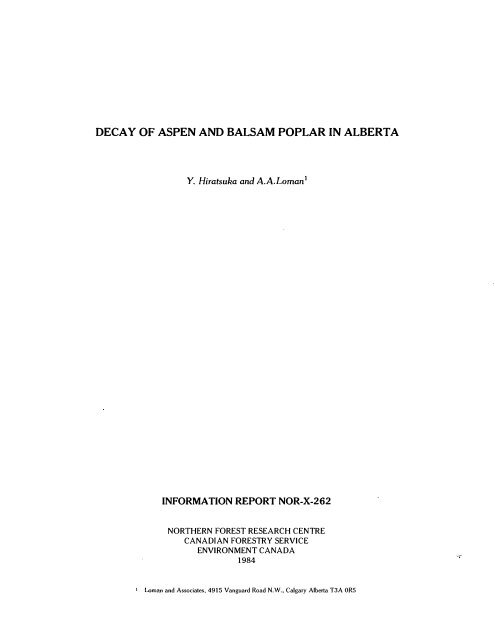
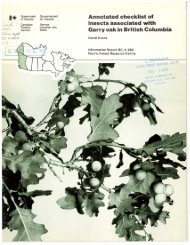
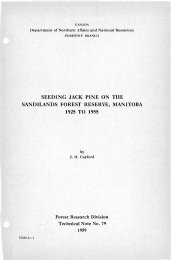
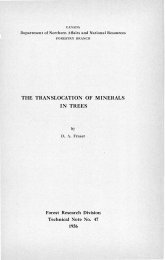
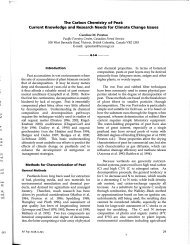


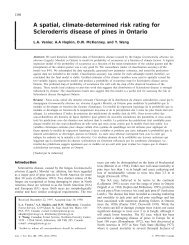

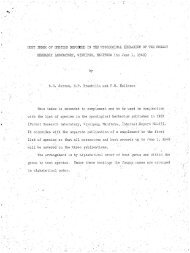
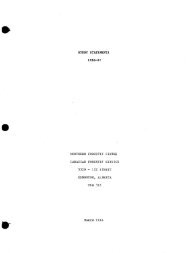
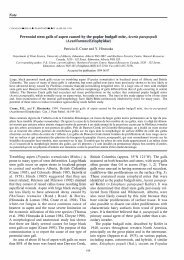
![Po],rell](https://img.yumpu.com/11946277/1/190x231/porell.jpg?quality=85)
